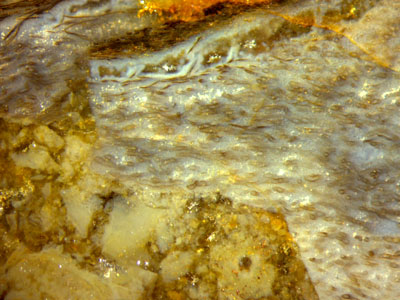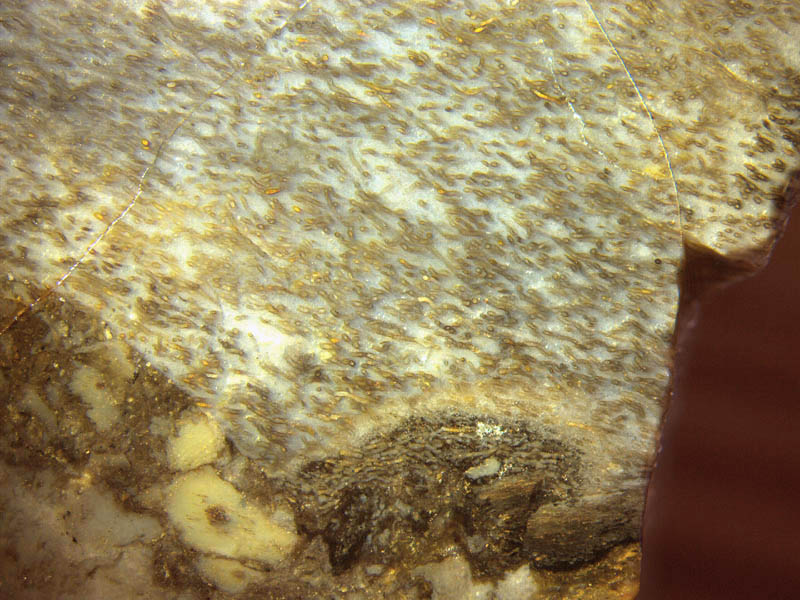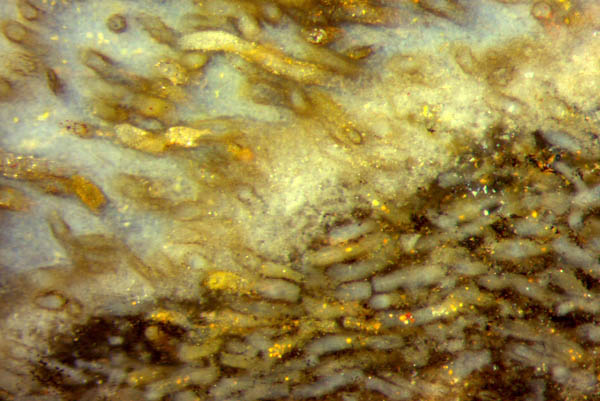Nematophyte twice protected
Since the most disputed nematophyte Prototaxites has
been sorted among the fungi [1-3],
these "enigmatic
organisms" [4] may have lost part of their attraction as something
mysterious among the living beings. Nevertheless it seems appropriate
to have a close look at the rare species found in the Rhynie chert,
some of which have probably never been seen before.
The unique nematophyte specimen shown in Rhynie
Chert News 98
is considered here anew. As there and in Figs.1,2 here, the
nematophyte, as a lump of gel with tubes inside, is
not seen as a whole but as a fragment with
distinct details which allow conclusions to be drawn.


Figs.1,2: Nematophyte:
a former brittle fragment
as a component
in Rhynie chert:
upper left part (left) and lower part,
same scale,
widths 5.5mm and 11mm.
Tubes surrounding themselves with organic
gel to live in is obviously a favourable way of life. In
water, the gel keeps the
tubes together, and it keeps them moist when transiently exposed to air.
During
drought, some gel near the surface dries, some tubes collapse, forming
a hard layer protecting the gel and tubes below, as seen in
Rhynie
Chert News 98,
there Fig.3,
and in this Fig.1, where
it appears as a dark crust above. A wide gap
between two fragments of the thick brown crust in Fig.2 below indicates
that the
crust had been hard and brittle while everything else was still soft.
Apparently the local damage of the crust served
as a starting point of a destructive process spreading through the
nematophyte. Possibly some microbe had entered, consuming the
organic gel between the tubes and the tube walls as well.

Evidently,
the decay spread as a front of certain depth, seen here as a
light-coloured zone (Figs.3,4).
The bluish-white organic gel turned into a dark
fluid in this process. What is seen in the affected area
does not look like tubes without gel but rather
like some tube fill fragments. Possibly the interior of all tubes had
become slightly silicified while the gel was not yet, then the gel and
the tube walls were consumed by the decay process, and the tube fills
settled down, where they are seen as whitish "worms" in dark "brine".
It is readily seen in Fig.1 that the nematophyte,
which originally had been gel
with tubes, must have hardened into a mechanically homogeneous solid
material, then broken in a brittle way, judging from the smooth
fracture faces. The edgy fragment must somehow have gotten into the
then fluid swamp matter with remains of land plants, where all together
turned into chert.

Fig.3 (left):
Locally rotting nematophyte, with rot spreading from the broken
protective crust below into the lump of gel with tubes; detail of
Fig.2, width 5mm.
Fig.4 (right): Locally
rotting nematophyte; detail of Fig.3,
width 2mm.

Fig.5 (left): Broken fills of nematophyte tubes with mineral
precipitates; detail of Fig.4, width 0.3mm.
The yellow (and red) mineral grains in some
of the tube fills (Fig.5), which had not settled into a deposit at the
bottom,
indicate that the tube content was not fluid when they grew. Settled
mineral grains in nematophyte tubes have been reported in
Rhynie
Chert News 154.
That
sample has something else in common with this one, which is the
uncommonly large tubes, mostly about 50Ám or larger. The diameter of
the tubes with yellow fill in Fig.4, for example, is about 60Ám. Other
tubes in this sample reach 70Ám.
Finally it can be stated that this unnamed nematophyte with large
tubes, and probably
others,
too, had been able to successfully protect themselves with a hard crust
against exsiccation and microbial attack as well.
Sample Rh13/7 (0.25kg), Part 2, described in Rhynie
Chert News 13.
H.-J.
Weiss 2020
[1] T.N. Taylor, M. Krings,
E.L. Taylor: Fossil Fungi. Elsevier 2015.
[2]
H. Steur: Prototaxites.
Google: steurh.home.xs4all.nl/engprot/
[3] R.
Honegger, D. Edwards, L. Axe, Ch. Strullu-Derrien:
Fertile Prototaxites
taiti: a basal ascomycete with
inoperculate, polysporous asci lacking croziers.
Phil.Trans. Roy. Soc. B 373 (2017): 20170146.
[4] T.N. Taylor,
E.L.Taylor, M. Krings: Paleobotany, Elsevier 2009.
 |
 |
155 |








